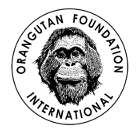I had the pleasure of participating in Orangutan Foundation International’s Eco tour in July 2010 together with eleven others from the US and UK, organised by Irene Spencer and led by Dr. Biruté Mary Galdikas. During our tour of the Orangutan Care Center we were introduced to an orangutan called Rosemary and her daughter Rodnee,… Continue reading Saving Rosemary and ESRI: Returning to the Light!

